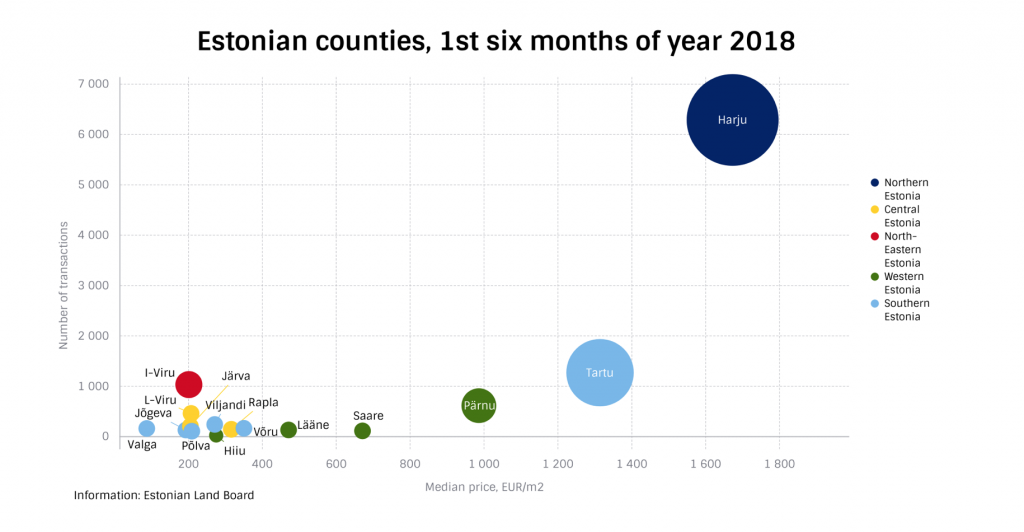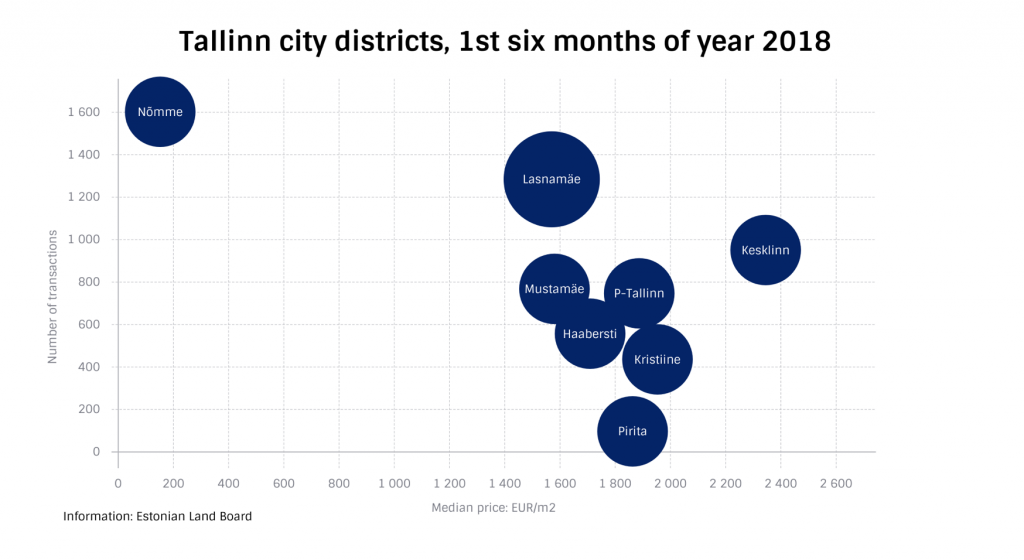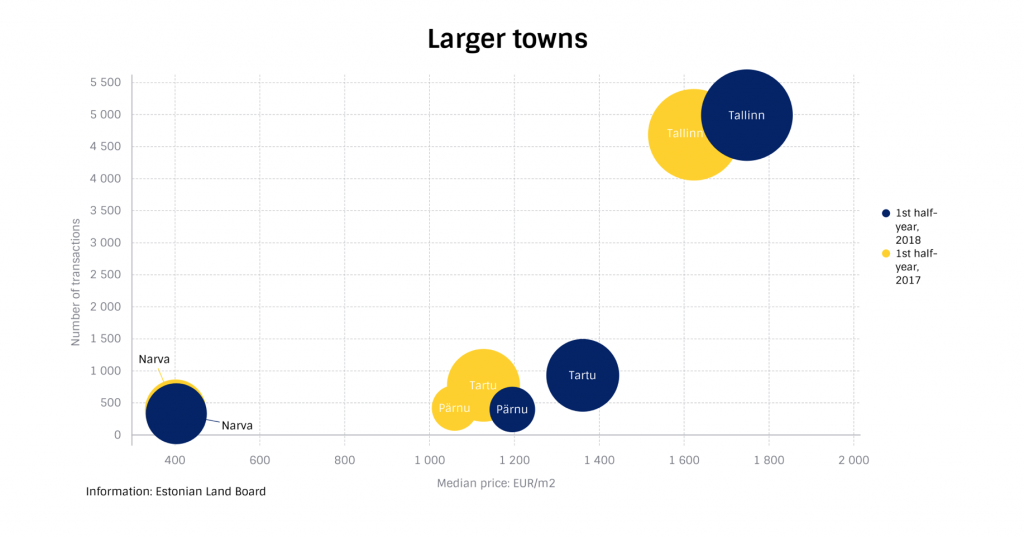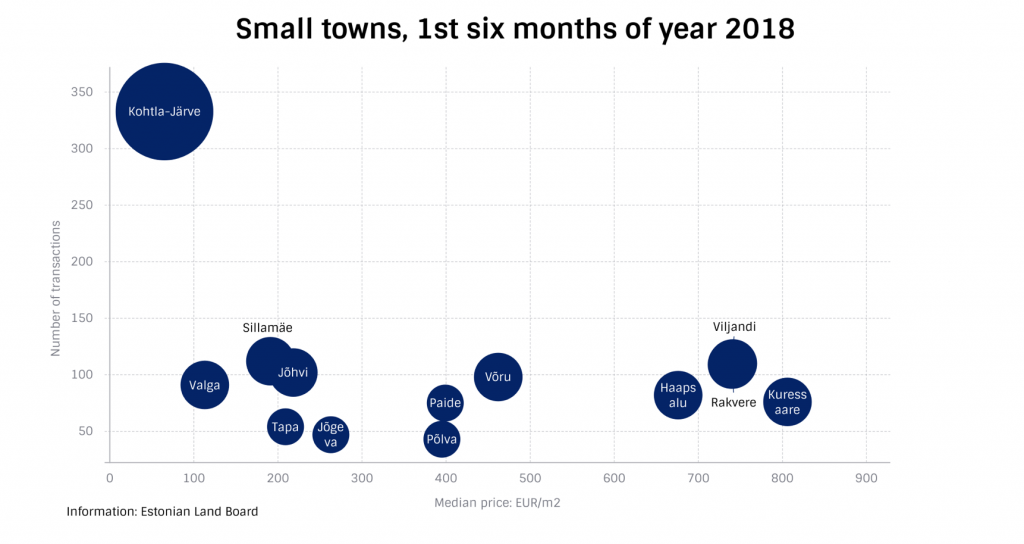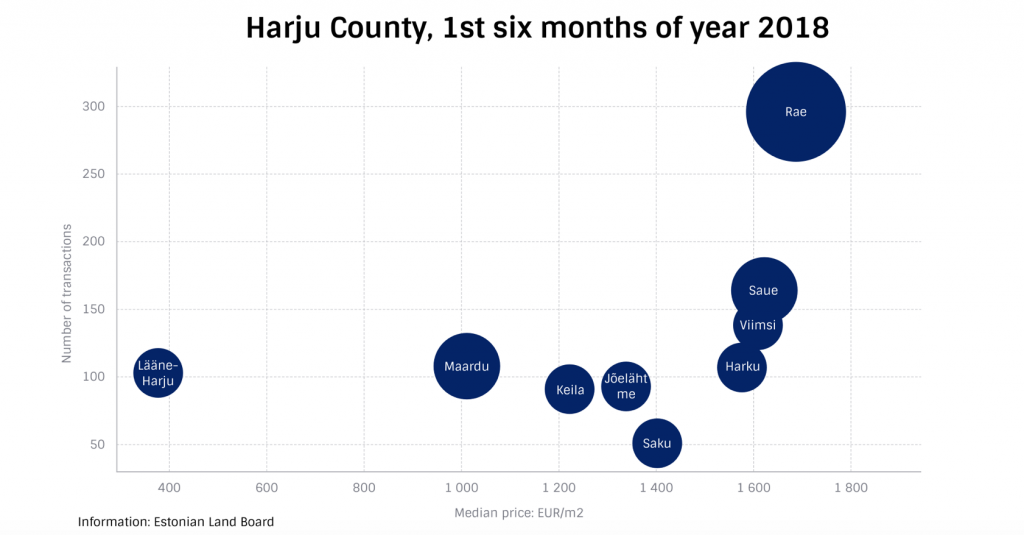June finished up the first half of the year, giving us a chance to stop for a moment and take a longer look at the changes having taken place over a longer period than the usual month. Even though the Estonian real estate market has developed at different speeds and in different directions, the total picture we have is rather positive, based on both the statistics and the general sentiment. Increased wealth and security has enabled more and more people purchase real estate, making it possible to shape a suitable environment supporting the development of personal life. The geography of new developments is expanding year-by-year, and based on the activity of Tallinn as the largest market it can be seen that regardless of the large construction volumes, interest in new apartments is still great, which in turn also supports the sustainability of the secondary market.
In the 1st half of year 2018, 11,101 transactions with apartment ownerships were concluded, by 354 transactions (3.3%) more than during the same period last year. At the county level, the change in the number of transactions was still very uneven. On the one hand, the development and the real estate market of the areas is very different, on the other hand, also the sizes of the markets are different – in a small market, every transaction contributes to the statistics considerably more than in a large market. In Harju County, the number of transactions increased by 426, in the rest of Estonia, outside the Harju County, the number of transactions dropped by 72. In Ida-Viru County, the number of transactions dropped by 87, more than 40 transactions less were also concluded in Pärnu and Rapla counties. Next to Harju County (6,288 transactions), during the 1st six months the largest number of transactions took place in Tartu County (1,270), Ida-Viru County (1,033) and Pärnu County (615).
Unlike the number of transactions, the growth in the median price was extensive: in comparison to the same period last year, the median price of transactions increased in ten counties. Even though the better part belongs to new developments still dominated by Harju County, changes have taken place also in the secondary market where the price increase does not give reason to talk only about the influence of new developments. The total median price of transactions in the 1st six months of year 2018 was 1,348 EUR/m2, and in comparison to the same period last year, it increased even by 13.1%. Such a quick increase in price has surpassed even the boldest of forecasts and was definitely facilitated by various factors, including the increase in the construction prices that exceeded all expectations. The median price was highest in Harju County (1,673 EUR/m2) where the prices increased by 8.3%, followed by Tartu County (1,314 EUR/m2) and Pärnu County (986 EUR/m2) – in the latter two, the prices increased over 10%.
Due to the fact that new developments are focusing increasingly in Tallinn and its surroundings, the real estate market has started to look increasingly similar to Harju County – in the 1st half of year 2018, the share of Harju County in the total value of apartment transactions was 79.1% and that of Tallinn was 64.7%. As the geography of new developments expands, the share of Harju County in the total value of transactions has mostly increased in the past years, whereas the share of Tallinn has remained stable. In the 1st six months, 4,992 transactions were concluded in Tallinn, which was 6.5% more than the year before; the median price increased by 7.7%, reaching 1,748 EUR/m2.
The largest number of transactions were concluded in Lasnamäe district where 1,284 transactions were concluded, which was 175 transactions more than the year before. The continued popularity of the outskirts among developers and buyers was also illustrated by the strong growth in the number of transactions in Haabersti (+75) and Mustamäe (+62). Of larger city districts, a noticeable drop in the number of transactions could be observed only in Northern Tallinn (–50) where the volume of new developments has somewhat decreased. The growth in the median price was strong in the 1st six months – only in Nõmme district the median price increased less than 8%, in Haabersti and Pirita, the price increase exceeded the line of 10%. The median price was highest in the Centre (2,345 EUR/m2) and lowest in Lasnamäe (1,570 EUR/m2).
In Tartu, compared to the same period last year, the number of transactions increased by more than 150 and the median price more than 20%. Such a strong growth was based on the increased share of new developments as well as the general price increase that has not left also the cheaper-end apartments in panel buildings untouched. In the 1st six months of 2018, 931 sale/purchase contracts were concluded in Tartu, the median price was 1,361 EUR/m2.
As to Pärnu, when adding up the data of this year, it can be confirmed that a large increase is usually followed by calmer development. The market of Pärnu awakened largely in year 2017, and the 1st half of year 2018 did not reach such a level of transactions. In the 1st six months of this year, 398 transactions were concluded, which is by 23 transactions less than last year. However, the median price of the transactions continued to grow virtually in a similar way – by 12.8% (1,195 EUR/m2).
Regardless of the social events influencing the image of Narva, peaked by the temporary movement of the President’s Office, no effect of those can yet be observed in the real estate market of Narva. It is possibly the beginning of a chain of positive events taking place with a certain delay. It is clear that in the interest of the development of Narva and Ida-Viru County on a wider scale, it must be preserved as an integral part of Estonia. In the 1st six months of 2018, 332 transactions with apartment ownerships were concluded in Narva, the median price was 403 EUR/m2. Even though the median price was similar to the same period last year, the number of transactions was lower by nearly 60.
Estonian small towns have reacted to the rise of the real estate market rather differently. The decrease in population has already reached a level where the total number of transactions has started to drop (of the fifteen towns under observation, the number of transactions increased in four) but the prices have moved in the opposite direction (of the 15 towns under observation, the median price increased in 10). Compared to the 1st half of last year, the decrease in both the number of transactions and the price has only touched two towns: Kohtla-Järve and Valga characterized by low incomes, high unemployment rate, quick decrease in population and poor image. There were three examples contrary to the above: Keila, Paide and Tapa. If in the first two towns the number of transactions remained the same compared to the same period last year, in Tapa both the number of transactions and the median price increased. Next to Keila, the median price exceeded the line of 1,000 EUR/m2 in Maardu and 700 EUR/m2 in Kuressaare, Rakvere and Viljandi.
The municipalities of Harju County have traditionally been the first to reflect the developments of Tallinn. In the municipalities where at least 50 transactions were concluded (seven in total), compared to the same period last year, the number of transactions increased in all of them and the median price in six. Only in Viimsi municipality, 30 transactions less than last year were concluded. The price level of the municipalities in the upper end of the price scale is similar to the outskirts of Tallinn – in the 1st six months of year 2018, the median price of transactions was 1,687 EUR/m2 in Rae municipality, 1,622 EUR/m2 in Saue municipality, 1,607 EUR/m2 in Viimsi municipality and 1,576 EUR/m2 in Harku municipality.


